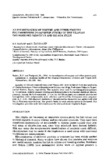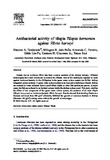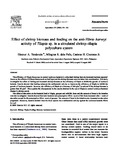| dc.contributor.author | Pantastico, Julia B. | |
| dc.contributor.author | Baldia, Jose P. | |
| dc.contributor.author | Reyes Jr., Deogracias | |
| dc.contributor.editor | Cho, C. Y. | |
| dc.contributor.editor | Cowey, C. B. | |
| dc.contributor.editor | Watanabe, T. | |
| dc.date.accessioned | 2011-06-22T09:34:59Z | |
| dc.date.available | 2011-06-22T09:34:59Z | |
| dc.date.issued | 1985 | |
| dc.identifier.citation | Pantastico, J. B., Baldia, J. P., & Reyes Jr., D. (1985). Acceptability of five species of freshwater algae to tilapia (Oreochromis niloticus) fry. In C. Y. Cho, C. B. Cowey, & T. Watanabe (Eds.), Finfish Nutrition in Asia : Methodological Approaches to Research and Development (pp. 136-144). Ottawa, Canada: International Development Research Centre. | en |
| dc.identifier.uri | http://hdl.handle.net/10862/254 | |
| dc.description.abstract | Unialgal cultures of Oscillatoria quadripunctulata, Chroococcus dispersus, Navicula notha, Euglena elongata, and Chlorella ellipsoidea were fed to tilapia fry for 30 days. Mean weights and survival rates of the fry were highest when given Navicula (105.6 mg, 86%) and Chroococcus (89.1 mg, 90%). Oscillatoria, a filamentous cyanophyte, showed limited acceptability to tilapia fry, possibly because of its larger size in comparison with Chroococcus. Fry fed Chlorella and Euglena did not survive at all.
C14-labeled algae of the above species were fed to tilapia fry of varying ages. Assimilation rates per fry after 24 hours of feeding with a suitable algal species increased with the age of the fry. Moreover, the same trend as in the growth and survival experiments was observed, i.e., the highest assimilation rates were obtained in 40-day old tilapia fry given Navicula and Chroococcus as natural feeds. On the other hand, negligible amounts of the other three algal species tested were assimilated by tilapia fry.
The above results were explained in terms of the enzyme secretion of tilapias. There seemed to be no transition stage in the feeding habit of both fry and adult tilapia. The acceptability of plant matter in the diet of even the early larval stages was demonstrated. | en |
| dc.language.iso | en | en |
| dc.publisher | International Development Research Centre | en |
| dc.subject | Tilapia culture | en |
| dc.subject | Fry | en |
| dc.subject | Food organisms | en |
| dc.subject | Phytoplankton | en |
| dc.subject | Acceptance tests | en |
| dc.subject | Philippines | en |
| dc.subject | Algae | en |
| dc.subject | Tilapia | en |
| dc.subject | Oreochromis niloticus | en |
| dc.subject | Oscillatoria quadripunctulata | en |
| dc.subject | Chroococcus dispersus | en |
| dc.subject | Navicula notha | en |
| dc.subject | Euglena elongata | en |
| dc.subject | Chlorella ellipsoidea | en |
| dc.subject.lcc | VF SP 036 | |
| dc.title | Acceptability of five species of freshwater algae to tilapia (Oreochromis niloticus) fry | en |
| dc.type | Conference paper | en |
| dc.citation.spage | 136 | |
| dc.citation.epage | 144 | |
| dc.citation.conferenceTitle | Finfish Nutrition in Asia : Methodological Approaches to Research and Development | en |



